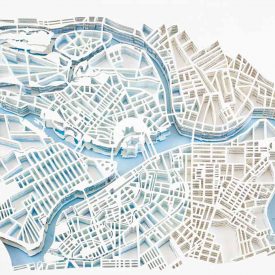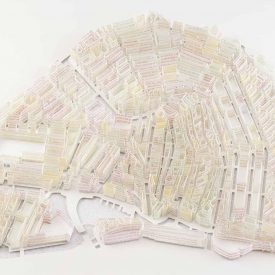Score of “The Ring” by Wagner photo: Rob Jaffe
On Tuesday, February 13th 1945 the city of Dresden was almost completely destroyed by fire in one of World War Two’s most infamous acts. History was repeating itself here as this was not the first time that such a fate had befallen Dresden. Some 200 years earlier in 1760 a large Prussian force overwhelmed the defending Austrian troops. Half the cities built up area was destroyed and many of it’s finest palaces lost entirely, though the Frauenkirche survived, this time.. In a grim pre curser of the destruction of 1945 much of the city was destroyed by fire, as the Prussians used oil filled incendiary bombs. Five years later a visitor from Frankfurt reported “Dresden no longer exists in its entirety. Its best and most beautiful places have been reduced to ashes. Its greatest palaces and streets, where art and pomp competed for ascendancy, are heaps of stones…” A quote that as we shall see is almost interchangeable with quotes from two centuries later.
Richard Wagner was resident in Dresden during the 1840s and became involved in the revolutionary action which culminated in the revolution of 1849. Wagner was eventually forced to become exiled in Switzerland where he finished the Nibelungen. whilst in Dresden he wrote passionate articles in the Volksblatter urging people to revolt. He took an active part in the fighting and was a lookout at the top of the Frauenkirche. During this time he became close friends with anarchist and revolutionary Mikhail Bakunin. Mikhail Bakunin was a major influence upon Wagner at the time of the writing of the Ring of the Nibelungen, as were the writings of Ludwig Feuerbach. Bakunin frequently talked of the desire to burn Paris to the ground to purify society through the purification of fire, something that became a central element in the Ring cycle. Of course, ironically, the city he conceived the great work in was itself totally consumed by fire. Fortunately for Wagner and Bakunin they were not alive to witness the horrors that idealogy bought to the 20th Century.
After 1945 Germany lay in ruins, it’s cities and culture reduced to rubble, the citizenry traumatized and internally destroyed. Dresden had perhaps fared the worst of any German city, being completely decimated by the double bombing of the night of February 13th, the entire city being effectively incinerated. The bombing of Dresden mirrored that of Coventry earlier in the war, which suffered from bombing with incendiary devices and was also subject to a double wave of bombers. During that night Prince Ernst Heinrich of Saxony watched as the capital his ancestors built burned to the ground. “The entire city was a sea of flame. This was the end! Glorious Dresden was burning, our Florence on the Elbe, in which my family had resided for almost four hundred years had been destroyed in a single night! I stood as if turned to stone” Very little has been written by the survivors of the German cities, the experience was too traumatic to be conveyed in words, in the words of W.G Sebald “The right to silence claimed by the majority of these people is as inviolable as that of the survivors of Hiroshima, of whom Kenzaburo Oe says, in his notes on the city written in 1965, that even twenty years after the bomb fell many of them still could not speak of what happened that day” Maria Ritter writes “On the way to Chemnitz, the train passed the city of Dresden. The two sisters sat next to each other as they looked out the window of the train compartment and saw that the familiar silhouette of the city with its famous towers was gone forever, erased to the ground. Nothing was left – just ruins. They both wept. Their city was dead, along with their mother and older sister” This generation of Germans lost their homeland and many went into permanent exile. As Jean Amery said “The destruction of someone’s native land is as one with that person’s destruction. Seperation becomes a rending, and there can be no new homeland” “Home is the land of one’s childhood and youth. Whoever has lost it remains lost himself”
The sculpture of Dresden uses the music score of Richard Wagner’s ring, itself born out of revolution and influenced by ideological and destructive fantasies. An artist whose work came to be used by the Nazis for the glorification of the German myth. The sculpture bears silent testament to the former inhabitants of Dresden and the vanished life lived within it. A reminder that even the greatest cultural achievements of humanity can be squandered and lost. In the sculpture the burnt and partially destroyed music score is used for the walls of Dresden. The sculpture was created using a map of Dresden from 1945. Perhaps the burning of the music score alludes to the cultural vandalism of the time and represents the end of a particular chapter of German culture and the end of this work of art’s appropriation for the purposes of national and political sentiment. The work was far greater than this narrow interpretation and lives on today and is performed widely. Meantime the Frauenkirch has been rebuilt and Dresden lives on in it’s third reincarnation, bearing witness to the remarkable ability of humanity to gather up the fragments of the past and rebuild anew.

















